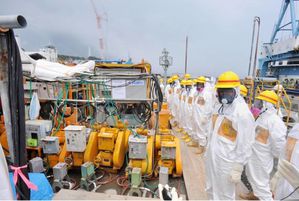
information about Fukushima published in English in Japanese media info publiée en anglais dans la presse japonaise
6 Août 2013
August 6, 2013
 Line in the sand: Members of a safety committee monitoring the Fukushima No. 1 power plant visit the area Tuesday near reactors 1 and 2 where Tokyo Electric Power Co. is building 'chemical walls.' | KYODO
Line in the sand: Members of a safety committee monitoring the Fukushima No. 1 power plant visit the area Tuesday near reactors 1 and 2 where Tokyo Electric Power Co. is building 'chemical walls.' | KYODO
AP
Tokyo Electric Power Co. said Tuesday it is struggling in its latest efforts to stop radioactive groundwater from flowing into the sea at the Fukushima No. 1 nuclear plant.
Tepco said some of the water is getting over or around “chemical walls” it created by injecting chemicals into the soil that solidify into a wall.
The latest problem involves groundwater that has built up over the last month, since Tepco started creating the chemical walls in an embankment to stop leaks after it detected radiation spikes in groundwater samples.
Tepco spokesman Yoshikazu Nagai said the company was slow to deal with the underground water problem while focusing on the melted reactors, which pose greater risks.
Measures to contain contaminated underground water leaks have lagged while “we devoted ourselves to cool the reactors,” which was the foremost task, Nagai said.
The plant still runs on makeshift equipment and has been plagued with blackouts and leaks from underground tanks.
Tepco has been repeatedly criticized for delayed handling and disclosures of problems and mishaps.
The Nuclear Regulation Authority set up a special panel with Tepco and met Friday to assess the water problem and discuss measures to resolve it. Watchdog officials have urged Tepco to pump the contaminated water inland and expand underground and seawater sampling. The utility is also building more layers of chemical walls around the embankment.
Officials acknowledged last month for the first time that the plant has been leaking radioactive water into the ocean for some time. After a major leak a month after the meltdowns, Tepco said it had contained the problem, and denied further underground leaks into the ocean until recently, though many experts have suspected that from early on.
Data provided by Tepco showed underground water at coastal monitoring points has risen over the chemical wall, obviously leaking into the sea.